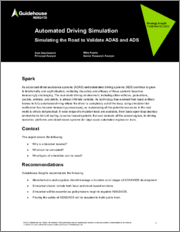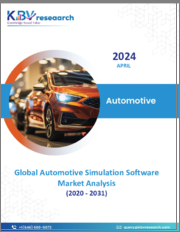
|
시장보고서
상품코드
1328595
자율주행 시뮬레이션 : ADAS와 ADS를 검증하기 위한 도로 시뮬레이션Automated Driving Simulation: Simulating the Road to Validate ADAS and ADS |
||||||
자동차 제조업체 및 공급업체는 해마다 ADAS(첨단운전자보조시스템) 및 ADS(자율주행 시스템)가 인간 운전자를 보완하거나 대체할 수 있는 범위를 계속 확대하고 있습니다. 주요 목표의 하나는 충돌사고를 줄이는 것으로 교통안전을 향상시키는 것입니다. 그러나 운전은 인간이 매우 높은 빈도로 시행하는 매우 복잡한 작업입니다. 미국에서만 사람들은 연간 3조 2,000억 마일의 거리를 운전하고 있으나, 사고는 평균 50만 마일에 1회 정도 밖에 일어나고 있지 않습니다.
ADAS와 ADS가 인간 운전자보다 실제로 안전한 것을 검증하는 것은 특히 운전 환경의 거의 무한 변동성과 테스트 조건 재현의 어려움을 생각하면 매우 높은 장벽입니다. 시뮬레이션은 과거 수십년간 자동차의 안전 시스템을 검증하기 위한 매우 중요한 툴이 되고 있으며, ADAS/ADS의 유효성을 증명하기 위해서도 필수적입니다.
ADAS/ADS 개발자는 새로운 컨셉을 검증하고, 이미 기능하는 것이 실증되고 있는 시스템에 변경이 있어도 에러가 발생하지 않는 것을 확인하기 위해 개발·시험 프로세스의 모든 단계에서 다양한 시뮬레이션 툴을 이용하고 있습니다. 소프트웨어·하드웨어·운전자를 루프에 포함한 오픈/클로즈드·루프 시뮬레이션은 모두 널리 사용되고 있습니다. 테스트 스위트의 충분한 커버리지를 확보하기 위해서는 테스트 시나리오를 생성하는 자동화 툴도 필요합니다. 대부분의 시뮬레이션 워크플로우는 복수 벤더의 다양한 툴을 조합하고 있으며, ADAS와 ADS가 공도에 도입되기 전에 안전성의 향상에 기여하는 것을 보증하는데 도움이 되고 있습니다.
목차
- 서론
- 배경
- 권장사항
- ADAS·ADS의 출현에 의한 시뮬레이션 수요의 증대
- 물리적인 운전 환경의 가상 공간에서의 재현
- 컴퓨팅 플랫폼
- 시뮬레이션 유형
- 유닛·서브시스템 시뮬레이션
- 풀 스택 시뮬레이션
- 소프트웨어 인 더 루프
- 하드웨어 인 더 루프
- 드라이버 인 더 루프
- 모델과 시나리오
- 차량의 물리적 모델링
- 센서 모델링
- 씬 모델링
- 시나리오 구축
- 모델 검증
- 안전한 자동화에 필요한 가상 검증
- 인프라 데이터의 수집과 공유
- 규제에 대한 전망
With each passing year, automakers and suppliers are continuing to expand the scope of what advanced driver assistance systems (ADAS) and automated driving systems (ADS) can do to supplement or replace human drivers. One of the primary goals is to improve road safety by reducing the number of crashes. However, driving is a very complex task that humans do with a very high frequency. In the US alone, people drive as much as 3.2 trillion miles per year and only crash about once every half million miles on average.
Validating that ADAS and ADS are actually safer than human drivers is a very high bar, particularly given the nearly infinite variability of the driving environment and the difficulty of reproducing test conditions. Simulation has become a crucial tool for validating automotive safety systems over the past several decades, and it is essential for proving the efficacy of ADAS/ADS.
ADAS/ADS developers rely on a range of simulation tools at all stages of the development and testing process to validate new concepts and ensure that changes have not caused errors in systems that are already demonstrated to work. Open- and closed-loop simulations with software, hardware, and drivers in the loop are all being used extensively. Automated tools to generate testing scenarios are also needed to ensure sufficient coverage of the test suite. Most simulation workflows combine a range of tools from multiple vendors to help guarantee that ADAS and ADS contribute to improved safety before the technology is deployed on public roads.
Table of Contents
Spark
Context
Recommendations
The Emergence of ADAS and ADS Drives Simulation Demand
Replicating the Physical Driving Environment in Virtual Space
Compute Platforms
Simulation Types
Unit and Subsystem Simulation
Full-Stack Simulation
Software in the Loop
Hardware in the Loop
Driver in the Loop
Models and Scenarios
Vehicle Physics Modeling
Sensor Modeling
Scene Modeling
Scenario Building
Model Validation
Safe Automation Needs Virtual Validation
Collecting and Sharing Infrastructure Data
Looking toward Regulations


















